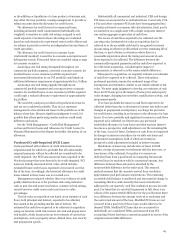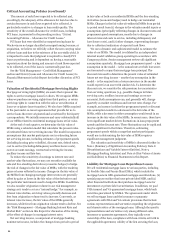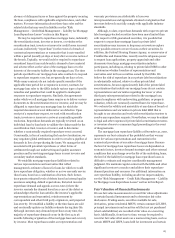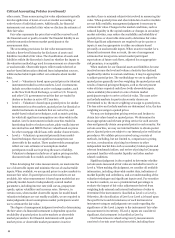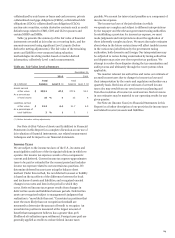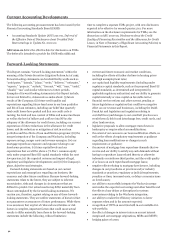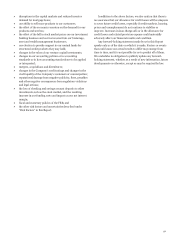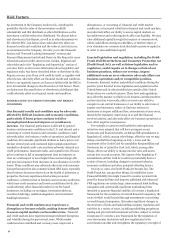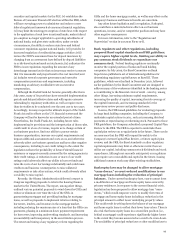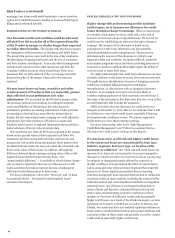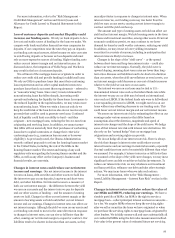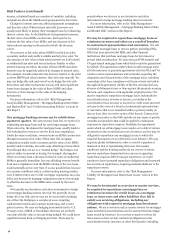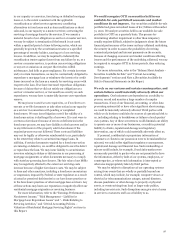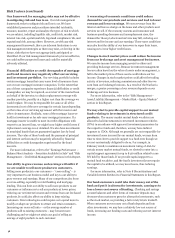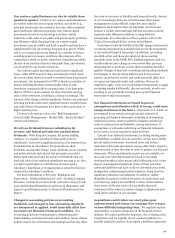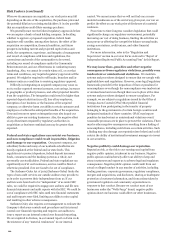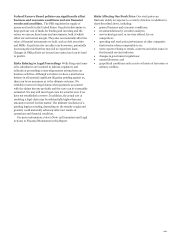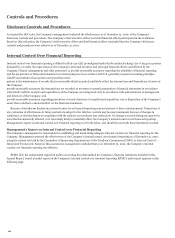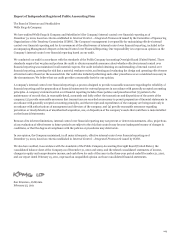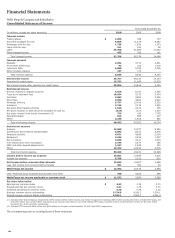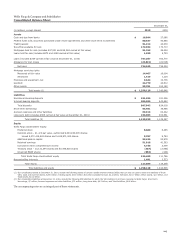Wells Fargo 2010 Annual Report Download - page 97
Download and view the complete annual report
Please find page 97 of the 2010 Wells Fargo annual report below. You can navigate through the pages in the report by either clicking on the pages listed below, or by using the keyword search tool below to find specific information within the annual report.For more information, refer to the “Risk Management –
Credit Risk Management” section and Note 6 (Loans and
Allowance for Credit Losses) to Financial Statements in this
Report.
Loss of customer deposits and market illiquidity could
increase our funding costs. We rely on bank deposits to be a
low cost and stable source of funding for the loans we make. We
compete with banks and other financial services companies for
deposits. If our competitors raise the rates they pay on deposits
our funding costs may increase, either because we raise our rates
to avoid losing deposits or because we lose deposits and must
rely on more expensive sources of funding. Higher funding costs
reduce our net interest margin and net interest income. As
discussed above, the integration of Wells Fargo and Wachovia
may result in the loss of customer deposits.
We sell most of the mortgage loans we originate in order to
reduce our credit risk and provide funding for additional loans.
We rely on GSEs to purchase loans that meet their conforming
loan requirements and on other capital markets investors to
purchase loans that do not meet those requirements – referred to
as “nonconforming” loans. Since 2007, investor demand for
nonconforming loans has fallen sharply, increasing credit
spreads and reducing the liquidity for those loans. In response to
the reduced liquidity in the capital markets, we may retain more
nonconforming loans. When we retain a loan not only do we
keep the credit risk of the loan but we also do not receive any sale
proceeds that could be used to generate new loans. Continued
lack of liquidity could limit our ability to fund – and thus
originate – new mortgage loans, reducing the fees we earn from
originating and servicing loans. In addition, we cannot assure
that GSEs will not materially limit their purchases of conforming
loans due to capital constraints or change their criteria for
conforming loans (e.g., maximum loan amount or borrower
eligibility). As previously noted, the Obama Administration
recently outlined proposals to reform the housing finance market
in the United States, including the role of the GSEs in the
housing finance market. The extent and timing of any such
regulatory reform regarding the housing finance market and the
GSEs, as well as any effect on the Company’s business and
financial results, are uncertain.
Changes in interest rates could reduce our net interest
income and earnings. Our net interest income is the interest
we earn on loans, debt securities and other assets we hold less
the interest we pay on our deposits, long-term and short-term
debt, and other liabilities. Net interest income is a measure of
both our net interest margin – the difference between the yield
we earn on our assets and the interest rate we pay for deposits
and our other sources of funding – and the amount of earning
assets we hold. Changes in either our net interest margin or the
amount of earning assets we hold could affect our net interest
income and our earnings. Changes in interest rates can affect our
net interest margin. Although the yield we earn on our assets and
our funding costs tend to move in the same direction in response
to changes in interest rates, one can rise or fall faster than the
other, causing our net interest margin to expand or contract. Our
liabilities tend to be shorter in duration than our assets, so they
may adjust faster in response to changes in interest rates. When
interest rates rise, our funding costs may rise faster than the
yield we earn on our assets, causing our net interest margin to
contract until the yield catches up.
The amount and type of earning assets we hold can affect our
yield and net interest margin. We hold earning assets in the form
of loans and investment securities, among other assets. If current
economic conditions persist, we may continue to see lower
demand for loans by credit worthy customers, reducing our yield.
In addition, we may invest in lower yielding investment
securities for a variety of reasons, including in anticipation that
interest rates are likely to increase.
Changes in the slope of the “yield curve” – or the spread
between short-term and long-term interest rates – could also
reduce our net interest margin. Normally, the yield curve is
upward sloping, meaning short-term rates are lower than long-
term rates. Because our liabilities tend to be shorter in duration
than our assets, when the yield curve flattens or even inverts, our
net interest margin could decrease as our cost of funds increases
relative to the yield we can earn on our assets.
The interest we earn on our loans may be tied to U.S.-
denominated interest rates such as the federal funds rate while
the interest we pay on our debt may be based on international
rates such as LIBOR. If the federal funds rate were to fall without
a corresponding decrease in LIBOR, we might earn less on our
loans without any offsetting decrease in our funding costs. This
could lower our net interest margin and our net interest income.
We assess our interest rate risk by estimating the effect on our
earnings under various scenarios that differ based on
assumptions about the direction, magnitude and speed of
interest rate changes and the slope of the yield curve. We hedge
some of that interest rate risk with interest rate derivatives. We
also rely on the “natural hedge” that our mortgage loan
originations and servicing rights can provide.
We do not hedge all of our interest rate risk. There is always
the risk that changes in interest rates could reduce our net
interest income and our earnings in material amounts, especially
if actual conditions turn out to be materially different than what
we assumed. For example, if interest rates rise or fall faster than
we assumed or the slope of the yield curve changes, we may incur
significant losses on debt securities we hold as investments. To
reduce our interest rate risk, we may rebalance our investment
and loan portfolios, refinance our debt and take other strategic
actions. We may incur losses when we take such actions.
For more information, refer to the “Risk Management –
Asset/Liability Management – Interest Rate Risk” section in this
Report.
Changes in interest rates could also reduce the value of
our MSRs and MHFS, reducing our earnings. We have a
sizeable portfolio of MSRs. An MSR is the right to service a
mortgage loan – collect principal, interest and escrow amounts –
for a fee. We acquire MSRs when we keep the servicing rights
after we sell or securitize the loans we have originated or when
we purchase the servicing rights to mortgage loans originated by
other lenders. We initially measure all and carry substantially all
our residential MSRs using the fair value measurement method.
Fair value is the present value of estimated future net servicing
95


